Ingredients You’ll Need to make Sauerkraut with Blueberries
- Cabbage: I suggest purple cabbage for this recipe, but you can use green cabbage, too. I think the purple cabbage looks so beautiful! A small head of cabbage will make about two jars of sauerkraut utilizing this recipe. At the store, look for a cabbage that still has outer leaves. Usually, if a cabbage still has its outer leaves, it’s more hydrated and fresh.
- Blueberries: Adding fruits to this recipe was exciting and successful! I’m having a good time experimenting with small amounts of fruit added to my sauerkraut fermentation projects. I used fresh, organic blueberries. Organic is always best with any berries, since berries are a “dirty dozen” crop.
- Coriander: For this recipe, I freshly ground whole coriander with a mortar and pestle. Toasting the coriander seeds first before grinding is also a fun way to add even more flavor.
- Sea Salt: I like to use unrefined solar-evaporated sea salt, but any pure sea salt will do. If you like experimenting with fancy sea salt in fermentation recipes, I suggest trying French grey sea salt.
- Water: I add water to all of my cabbage fermentation recipes. Water is still drawn out of the cabbage when salt is added. However, having water in this recipe accounts for seasonal changes in produce hydration levels. So, no matter where you are in the world, what your cabbage is like, or how long you have had a cabbage sitting in the fridge, you should succeed with this recipe.
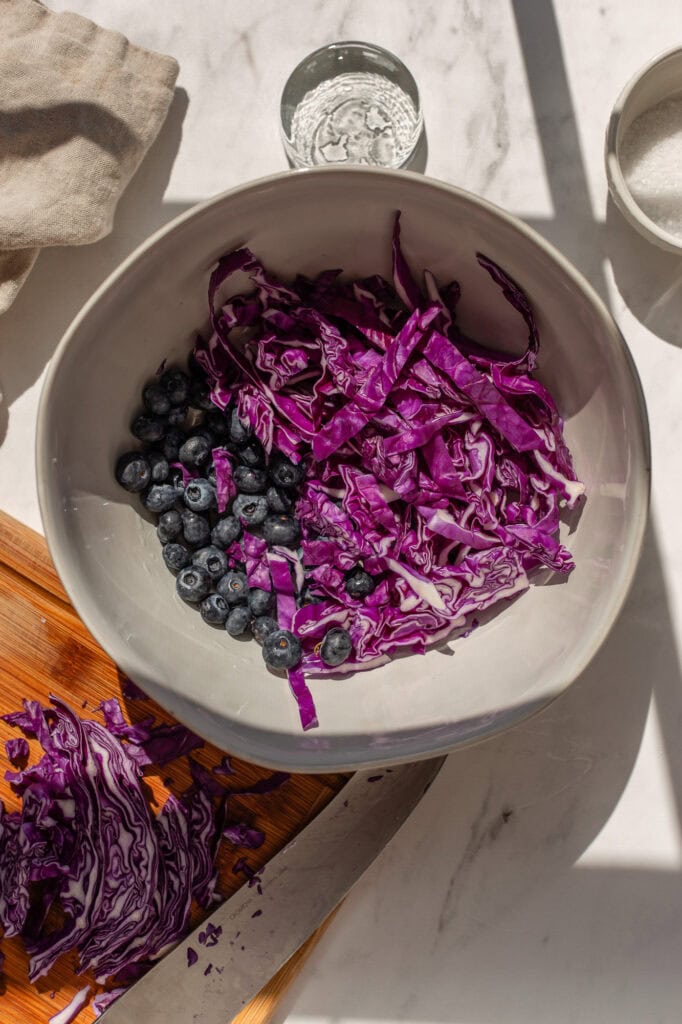
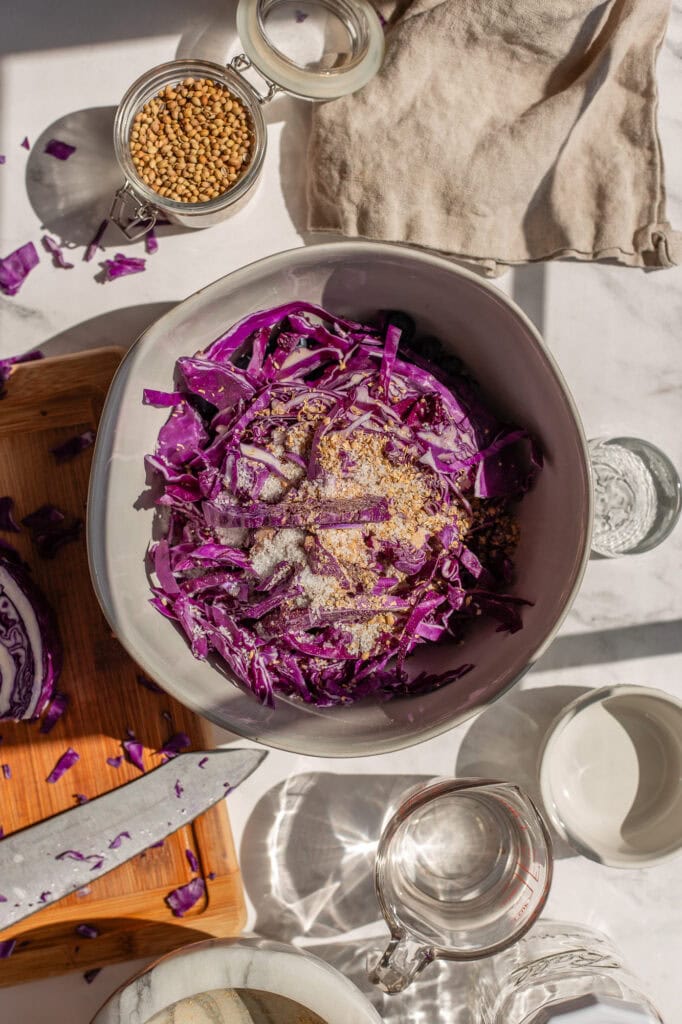
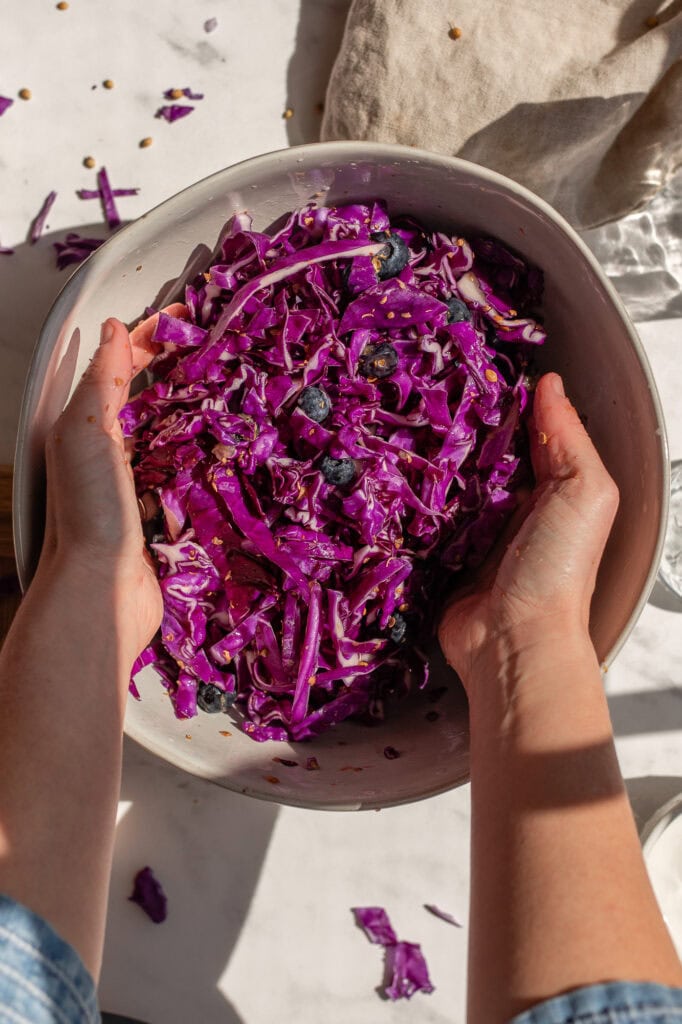
Fermenting Blueberries
Blueberries are great for lacto fermentation because they do not contain many FODMAPs. Usually, fruits that contain more fermentable sugar encourage yeast fermentation instead of lacto-fermentation. This isn’t an issue with blueberries because they’re low in all six FODMAPs, hence why they usually taste more tart than sweet. My favorite way to ferment them is by incorporating them with cabbage for a fun sauerkraut flavor with extra vitamin benefits.

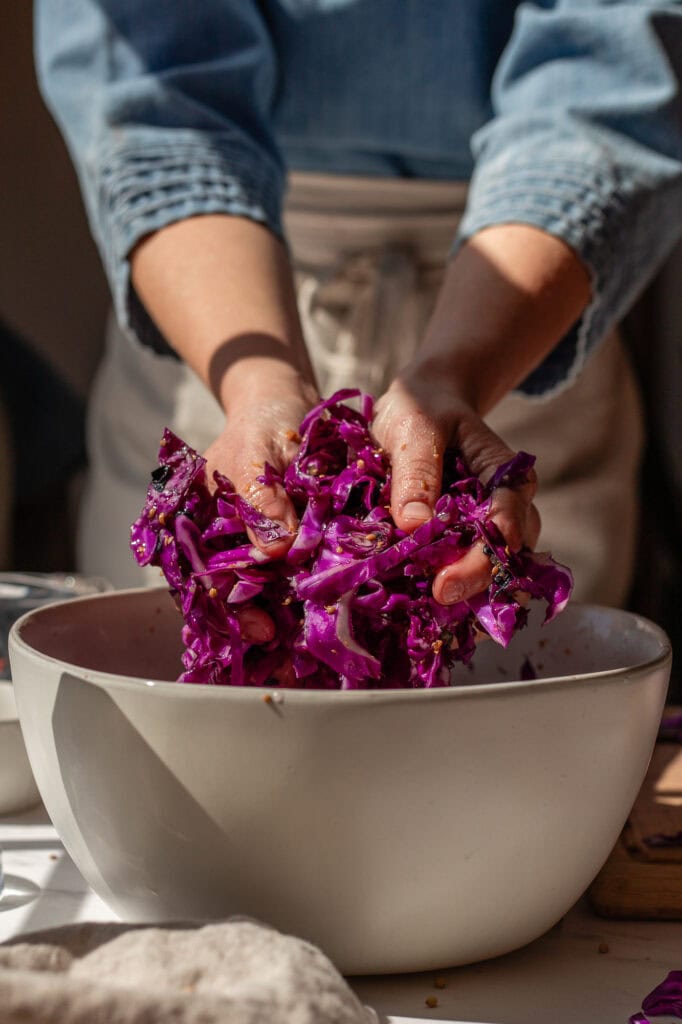
Supplies You Need to Make Sauerkraut with Blueberries
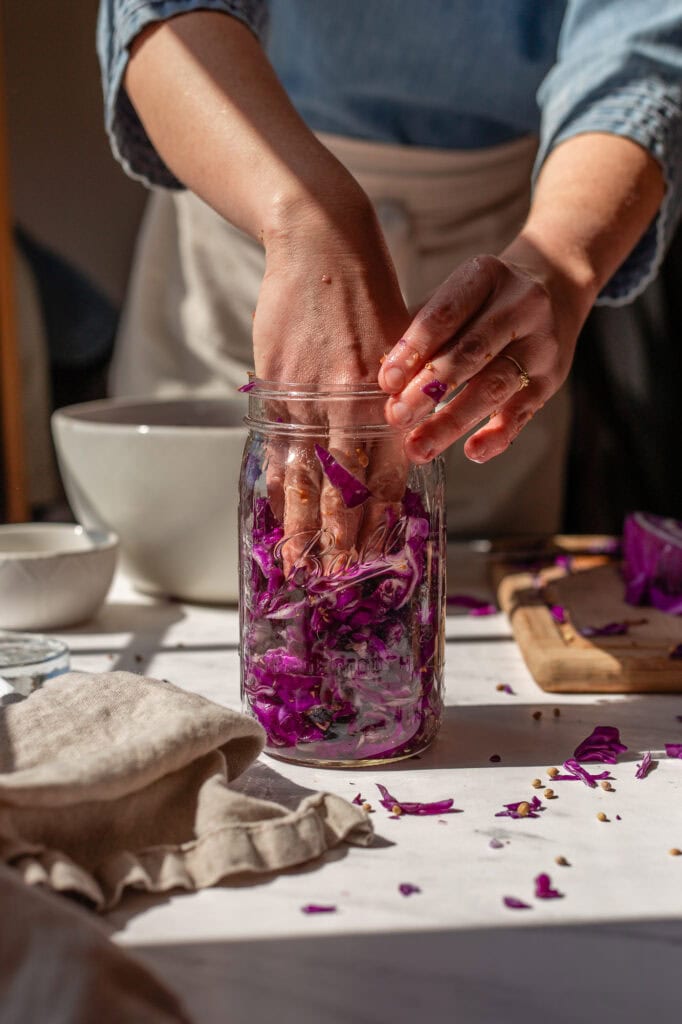
Fermented Blueberries in Sauerkraut
This Fermented Blueberries Sauerkraut naturally takes time. I recommend fermenting your sauerkraut for at least 14 days before eating, with 21-28 days being the best fermentation time for optimal flavor and health benefits.
We have provided you with a handy timeline below by checking the progress of microbial stages under the microscope! If you follow our recipe and directions, your timeline of sauerkraut fermentation should approximately match ours!
Note that temperature will influence how fast or slow sauerkraut ferments. This timeline applies between 70 ° F. and 80° F. If you keep your home colder, the process is slower. If your home is warmer, it will be faster.

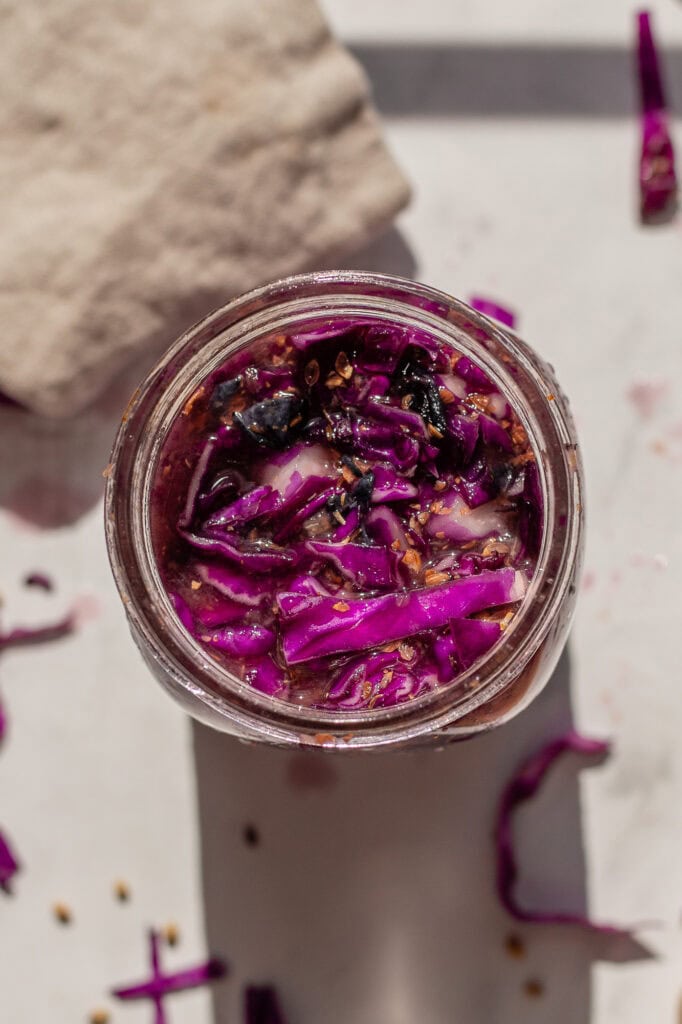
Blueberry Sauerkraut Timeline
24 – 48 hours: All contents in the jar should be submerged beneath the brine. At this time, there are still Gram-negative bacteria and possible pathogens present.
48 hours – 5 days: After 48 hours, you should start to see lots of bubbles being produced. This is when the ferment enters stage two of vegetable fermentation. Leuconostoc bacteria begin to thrive, and Gram-negative organisms die off.
5 – 10 days: The bubbles in the fermented blueberries sauerkraut brine will decrease as the ferment leaves stage two and enters stage three. The ferment will become cloudy, the color will change, and a pleasant sour smell will develop. You should also recognize light blueberry and coriander smells. Lactobacillus species begin to thrive at this time.
10 – 21 days: Next, Lactobacillus makes up most or all of the microbial population. They produce copious amounts of lactic acid, making the fermented cabbage smell even more pleasantly sour. This is when the vegetable mixture becomes sauerkraut and is preserved.
21 – 28 days: This is when you want to smell and taste test the kraut. Wait for it to smell and taste as you like, and refrigerate when you find the smell and taste most pleasant! We like ours best when we refrigerate it for about 25 days.
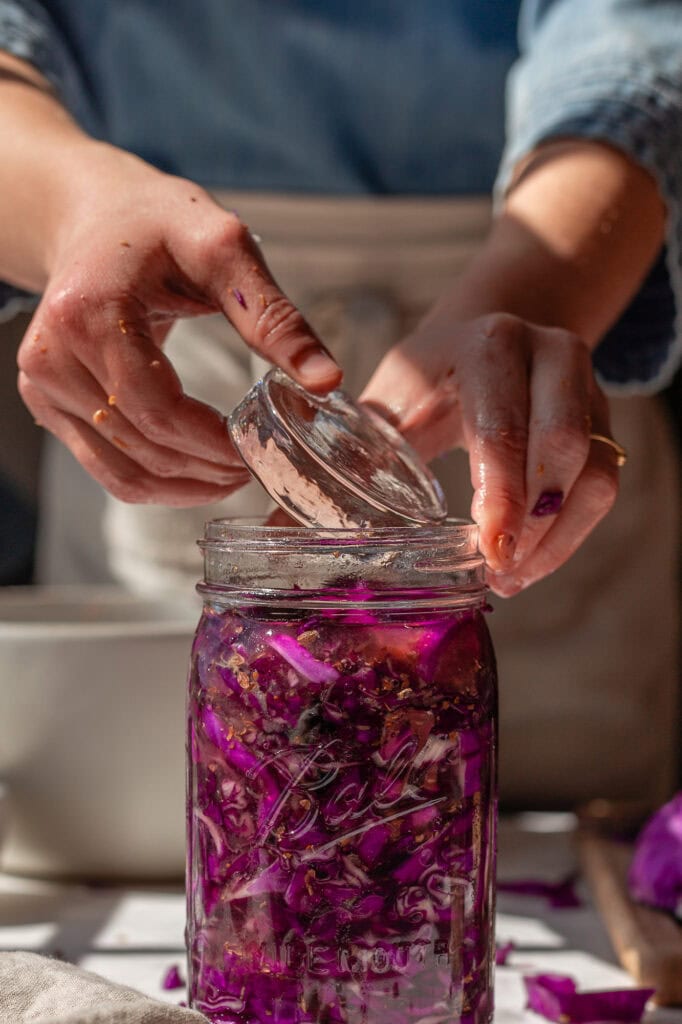
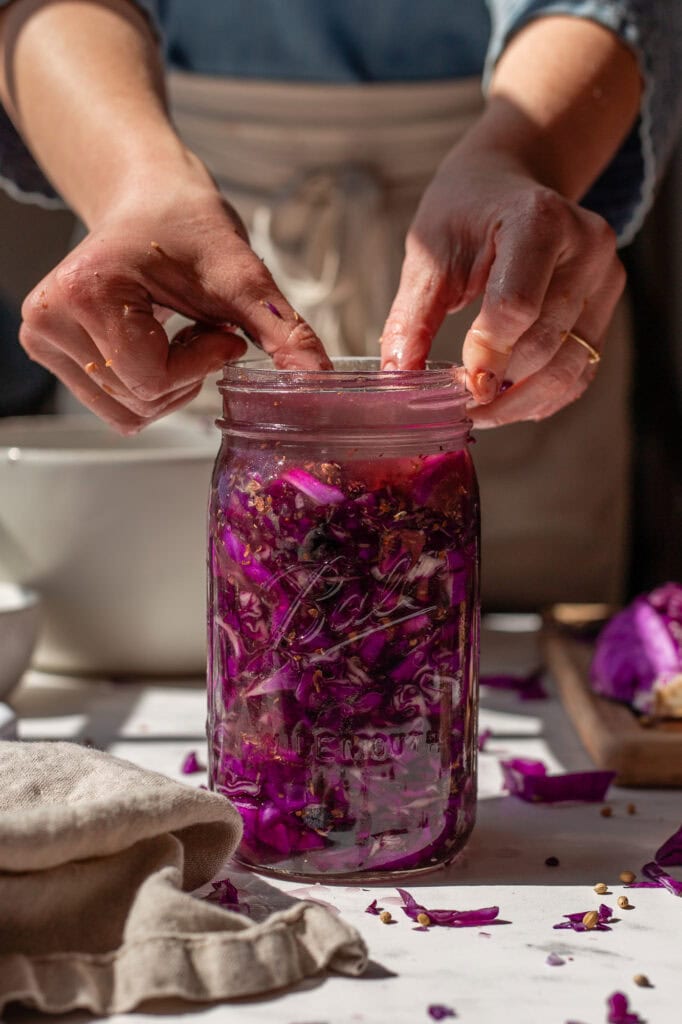
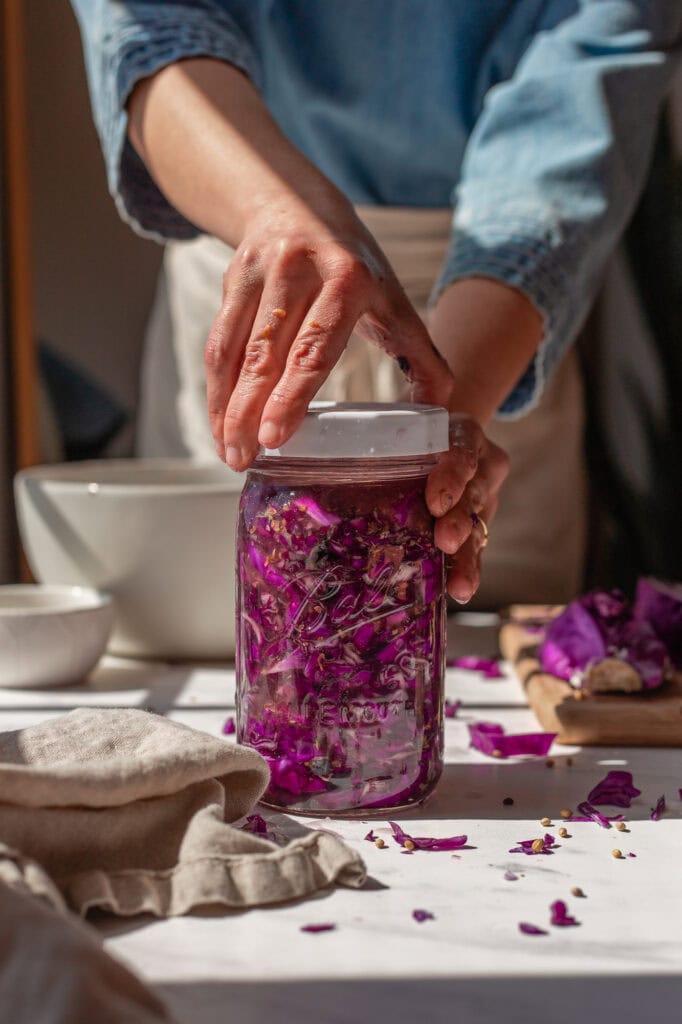
More Sauerkraut Recipes to Try
- How to Ferment Sauerkraut with Orange, Sesame, and Ginger
- Fermented Beet and Red Cabbage Sauerkraut
- Roasted Garlic Sauerkraut with Black Pepper


Fermented Blueberry Sauerkraut with Red Cabbage & Coriander
Did you know that you can add nutritious fruits, like blueberries, to sauerkraut? Well, you can! In this blog, I’ll teach you how to make my fermented blueberry sauerkraut with red cabbage, fresh blueberries and coriander.
- Prep: 10 minutes
- Total Time: 504 hours 10 minutes
Ingredients
- 500 grams purple cabbage
- 100 grams blueberries, fresh or frozen
- 200 grams filtered water
- 20 grams sea salt
- 2 teaspoons coriander, ground
Instructions
- Wash your fermentation equipment (jar, weight, and lid)
- Remove the outer leaves of your cabbage and lightly rinse with cool water. Using a knife, chop the cabbage to your desired thickness.
- Wash the blueberries. Defrost if using frozen.
- Place your kitchen scale on the counter. Turn it on and set it to weigh in grams.
- Measure out all of your ingredients using your kitchen scale.
- Mix all the ingredients, including the water, in a large bowl. Lightly massage the cabbage and break up any large pieces.
- Pack it all, including the water, into a clean jar with a rust-proof lid. (a 32-ounce jar works best)
- Place a fermentation weight in the jar, making sure to submerge the cabbage pieces and weight fully into the liquid. If you don’t have quite enough liquid, place your glass fermentation weight in the jar and submerge as much as possible. Over the next 12 hours, the cabbage should release more liquid and you can press the fermentation weight down below the brine.
- Secure the lid (you do not need to tighten it all the way. Just secure the lid but leave it ever so slightly loose so the gas doesn’t build up too much). You can keep the jar in a glass dish to catch any spills.
- Burping the jar: It should get bubbly in the first few days. If you have a tightly secured lid, you will need to burp the jar. You should also wash off the lid to keep it clean and re-adjust the fermentation weight whenever needed. Anytime the weight comes up out of the brine, with clean hands press hard on the weight to tamper everything back down into the liquid.
- Ferment at room temperature for 21-28 days, then remove the fermentation weight and refrigerate.
- If you try this recipe and love it, please leave a five-star review below!
Notes
- You can use frozen berries in this recipe! Just defrost them first.
- This recipe works best with a 32-ounce jar
- Taring/zeroing the scale with a container on it subtracts the weight of the container, allowing you to weigh only what is added to the container. After taring/zeroing the scale, it should read 0.0 with the container on it.


























I only have açaí powder. Can I use that?
I haven’t tried it, but it should work. The only issue would be the powder absorbing too much liquid.
Hi Kaitlynn! I also plan to make this but only have açaí powder. Would you recommend I still do the same 50grams of it. Or do I do less since it’ll absorb water?
Wow this was incredible! Thank you so much. Now I want to make a gallon of this.
you should totally make a gallon of it! Glad to hear you loved the sauerkraut!
Could you use frozen wild blueberries in place of fresh? Thanks.
yes! definitely!
This sounds amazing!! Can I use the pickle pipe (I think that what it’s called) to release any gas that might accumulate?
I don’t recommend those silicone lids. They’re a big cause of mold!
My kid and I just made this and it already smells divine! I forgot to defrost the blueberries though. Is this a problem?
not a problem! It’ll be fine!
I’m so excited about this but I’m about two weeks in and my jar is leaking?! Lots of fluid overflow. Any tips?
Open it up and press down on the fermentation weight to release the gas. Rinse the lid off while you’re at it!
Absolutely lovely recipe. Was so pleased with the outcome. Delicious
yay! Glad you love the sauerkraut! Thanks so much for leaving a review 🙂
Perfect also with black pepper instead coriander.
Supertolle Rezepte,ich fange gerade erst an, die Erklärungen sind gut verständlich,ich freue mich auf meine Ergebnisse,danke
LG. Inge Matzat
Vielen Dank, Inge! Es freut mich sehr, dass dir die Rezepte gefallen!
(I hope this makes sense! I used a translator!)
AMAZING. This recipe is so absolutely delicious. We made 1 jar and fell in love- so then we started another jar to make sure we have enough for the next few months before our purple cabbage is ripe again. HIGHLY HIGHLY recommend.
Just made this and it’s delicious! Color is beautiful as well. Just wondering how long it will last in the refrigerator? Thank you for sharing this recipe.
It’s doesn’t really have an expiration date! It can last in the fridge for 1-2 years.